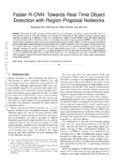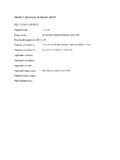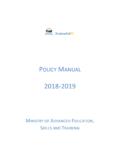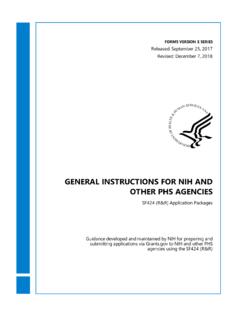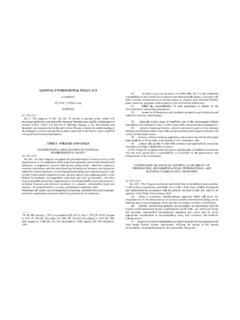Transcription of DEVELOPING SKILLS OF NGOS Project Proposal Writing
1 DEVELOPING SKILLS OF NGOS. Project Proposal Writing DEVELOPING SKILLS OF NGOS. Project Proposal Writing Written by BESIM NEBIU. Edited by ILDIKO SIMON and CERASELA STANCU. THE REGIONAL ENVIRONMENTAL CENTER. for Central and Eastern Europe About the REC. The Regional Environmental Center for Central and Eastern Europe (REC) is a non-partisan, non-advo- cacy, not-for-profit organisation with a mission to assist in solving environmental problems in Central and Eastern Europe (CEE). The Center fulfils this mission by encouraging cooperation among non-governmen- tal organisations, governments, businesses and other environmental stakeholders, by supporting the free exchange of information and by promoting public participation in environmental decision-making. The REC was established in 1990 by the United States, the European Commission and Hungary.
2 Today, the REC is legally based on a Charter signed by the governments of 27 countries and the European Commission, and on an International Agreement with the Government of Hungary. The REC has its headquarters in Szen- tendre, Hungary, and local offices in each of its 15 beneficiary CEE countries which are: Albania, Bosnia and Herzegovina, Bulgaria, Croatia, Czech Republic, Estonia, Hungary, Latvia, Lithuania, FYR Macedonia, Poland, Romania, Serbia and Montenegro, Slovakia and Slovenia. Recent donors are the European Commission and the governments of Albania, Belgium, Bosnia and Herzegovina, Bulgaria, Canada, the Czech Republic, Denmark, Estonia, Finland, France, Germany, Italy, Japan, Latvia, Lithuania, the Netherlands, Poland, Serbia and Montenegro, Slovenia, Sweden, Switzerland, the United Kingdom and the United States, as well as other inter-governmental and private institutions.
3 The entire contents of this publication are copyright 2002 The Regional Environmental Center for Central and Eastern Europe No part of this publication may be sold in any form or reproduced for sale without prior written permission of the copyright holder ISBN: 963 9424 18 8. Published by: The Regional Environmental Center for Central and Eastern Europe Ady Endre ut 9-11, 2000 Szentendre, Hungary Tel: (36-26) 504-000, Fax: (36-26) 311-294. E-mail: Web site: < >. Editing: Steven Graning, Design: Sylvia Magyar, Illustration: Laszlo Falvay This and all REC publications are printed on recycled paper or paper produced without the use of chlorine or chlorine-based chemicals. CONTENTS. Topic Material 5. Overview 7. Project Basics 9. How to Write a Project Proposal 12. training Toolkit 21. Tool 1: Ice Breaker, Introduction Exercise 23. Tool 2: Long Words 25.
4 Tool 3: Reservation Revenue 27. Tool 4: Where did it go? 29. Sample Workshop Agenda 31. Project Proposal Writing 3. 4 Project Proposal Writing . Topic Material Project Proposal Writing 5. 6 Project Proposal Writing . TO P I C M AT E R I A L. Overview Introduction Without direct Project funding, most non-governmental organisations (NGOs) would not be able to accomplish their goals. Writing clear, thorough and targeted Project pro- posals is therefore essential to an NGO's success. Mastering the art of Proposal Writing requires a unified approach to Project manage- ment. This guide is therefore intended to serve as a basis for delivering training sessions related to the process, as well as the end product of Project design. A Project Proposal is a detailed description of a series of activities aimed at solving a certain problem. The Proposal should contain a detailed explanation of the: justification of the Project .
5 Activities and implementation timeline;. methodology; and human, material and financial resources required. The Project Proposal should be a detailed and directed manifestation of the Project design. It is a means of presenting the Project to the outside world in a format that is immediately recognised and accepted. The training sessions on Project Proposal Writing aim to create an understanding of: the role of the Project Proposal and the activities related to each stage;. how to deal with projects and Project proposals from an organisational perspective;. how Project proposals fit into Project management; and how to structure a good Project Proposal . Objective of the Guide This guide will lead trainers through Project Proposal Writing sessions and exercises. It enables the user to: improve participants' SKILLS in DEVELOPING quality Project proposals.
6 Show them how to manage projects within an organisation; and help them to understand a Project 's value as a tool to achieve and further the organi- sation's mission. The challenges that come out of these problem areas can be classified into three groups: 1) Enhancing SKILLS and organisational procedures Learning Proposal - Writing techniques, as well as DEVELOPING SKILLS in designing and Writing successful Project proposals, is the objective of most participants Establishing systems and standards related to DEVELOPING projects within the NGOs is also a key objective. Project Proposal Writing 7. TO P I C M AT E R I A L. 2) Understanding the role of Project proposals in Project management The Project Proposal is a tool not a goal. It should be followed as closely as pos- sible, and deviations should occur only when necessary. Proposal Writing is only one of the phases of Project management.
7 It is one of the numerous actions that form a logical sequence of events usually referred to as the Project cycle. 3) Conducting preparatory work prior to Proposal Writing A quality Project Proposal is the final product of a participatory process that involves considerable study, discussion and learning from past experiences (see Figure 1). SKILLS to be Developed The training focuses on DEVELOPING specific SKILLS related to designing and complet- ing good Project proposals. This guide offers instruction in: conducting preparatory work (see Figure 1);. DEVELOPING comprehensive and viable Project plans by setting realistic goals and determining the resources needed;. FIGURE 1. Before Writing a Proposal Interview past and prospective beneficiaries. Though feedback was likely received when the previous Project ended, new benefits and conditions may have arisen since that time.
8 Speak to prospective beneficiaries to ensure that what you are planning to offer is desired and needed. Review past Project proposals. Avoid repeating mistakes and offering to reproduce results that have already been achieved. Donors will be unlikely to provide more funding for something that should already have been done. Review past Project evaluation reports. Don't count on Project members to remember all the mistakes and areas for improvement from previous efforts. Organise focus groups. Make sure that the people you need are willing and able to contribute. Check statistical data. Don't let others discover gaps and inaccuracies in the data you are relying on. Consult experts. Outside opinions will give you ideas and credibility. Conduct surveys, etc. Gather as much preliminary information as possible to demonstrate commitment to the Project and to refine the objectives.
9 Hold community meetings or forums. When the public feels that they have been consulted on an issue, they will be much more likely to cooperate and sup- port the Project . 8 Project Proposal Writing . TO P I C M AT E R I A L. completing the Project Proposal package in order to provide fun- ders with all necessary information; Main Terms of the preparing and following up on Project budgets; and Proposal Writing Process Writing budget reports. Indicators those elements of the Project plan that translate the Project 's purpose and results into measurable units (quantity or quality). Contents and thus provide the basis for This guide covers the following topic areas: measuring the impact Input the investment of resources What is and what is not a Project ? (human, material or financial). What is a Project design? invested in the Project Output the results achieved How are Project elements formulated?
10 Activity plan a description of Which methods are best for planning a Project ? the flow, timeline and responsibilities for the Project 's activities What is a Project Proposal ? Resource plan a description of How is a Project Proposal written? (suggested format covering all how the resources will be used in the aspects of the Project Proposal ) relation to the activities Gantt chart a specific model for It is a good idea for participants to familiarise themselves with the activity plans that illustrates how the main terms of the Proposal Writing process found at right. activities interconnect Income the funds secured for the Project 's implementation Delivering the training The guide should be used in combination with the activities pre- sented in the training toolkit. Most of the guide's content is designed in a way that can be used as a handout or reader for the participants during the training session.


